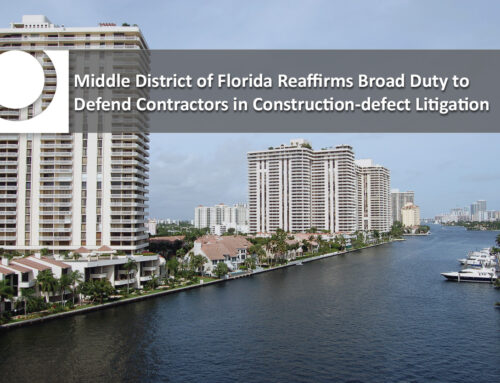The Seventh Circuit just released an opinion in Strauss v. Chubb Indemnity Insurance on November 18, 2014, upholding coverage for insureds who discovered the presence of long-term water damage five years after their insurance policies had expired, and likely well after the statute of limitations passed for a construction-defect action. With this opinion, the Seventh Circuit joins with other jurisdictions that have determined there is coverage for long-term latent defects that go undiscovered for years.
The insureds constructed a new home in Wisconsin that was completed in 1994. They moved in and purchased insurance with various insurers through 2005. But unknown to the insureds, the defective construction in 1994 had been allowing water to infiltrate their home. These damages went undiscovered until 2010, five years after the last insurance policy had expired and likely beyond the time allowed to file a lawsuit against the negligent contractor. The insurers denied coverage, arguing that there was no coverage for the water damage because it didn’t “manifest” until 2010 and a “manifestation trigger” applies to all first-party property insurance claims. Not only is that an incorrect statement of the language of the policies, it is also a blatant misstatement of the law. The district court rejected the insurers’ arguments. So did the Seventh Circuit.
It is a fundamental rule of insurance law that a “triggering event” must occur during the effective dates of an insurance policy. There are four different theories to determine whether a “triggering event” has occurred during a policy period, as summarized by the Seventh Circuit:
The “exposure” theory fixes the date of injury as the date on which the injury-producing agent first contacted the body or the date on which pollution began. The “manifestation” theory holds that the compensable injury does not occur until it manifests itself in the form of a diagnosable disease or ascertainable property damage. The “continuous trigger” theory, also known as the “triple trigger” theory, provides that the injury occurs continuously from exposure until manifestation. Finally, the “injury-in-fact” theory allows the finder of fact to place the injury at any point in time that the effects of exposure resulted in actual and compensable injury.
As between the “manifestation trigger” (which limits coverage to only one policy period) and the “continuous trigger” (which extends coverage to all policies in effect from the time the loss begins to the time the loss is discovered), the Seventh Circuit predicted that the Wisconsin Supreme Court would apply the “continuous trigger” rule. Wisconsin had already rejected the use of any single-trigger theory; instead, Wisconsin courts look to the policy language to determine the appropriate trigger theory.
The policy provisions clearly supported the application of the “continuous trigger” theory. Those provisions state that the policy covers “all risk of physical loss…unless stated otherwise,” and that the policies only apply to “occurrences that take place” during the effective dates of the policies. “Occurrence” was defined to include “continuous or repeated exposure to substantially the same general conditions.” These definitions are standard and are included in many property policies. Applying the “continuous trigger” theory, the Seventh Circuit held that the water infiltration caused by the faulty construction constituted a single occurrence under the policies, and because the policies covered “all risk of physical loss” the water damage triggered coverage. In addition, because there was continuous, recurring damage caused by each successive rainstorm between 1994 and 2010, the insureds would have coverage for all of the damage occurring during that time frame.
The insurers also argued that the insureds didn’t sue them in the time period provided by the terms of the policies. Wisconsin law provides that lawsuits on first-party claims must be filed within one year “after the inception of the loss.” The policies, however, said something different. They permitted claims to the filed “within one year after a loss occurs.” The Seventh Circuit found this difference in language to be compelling. It held that “after the date of loss” language could reasonably be interpreted to mean the insureds could have filed their lawsuit “at any point up until a year after the water infiltration damage halted.” As such, the court rejected the insurers’ arguments that the suit was time-barred.
This case is a great example of insurers shoe-horning broad arguments into situations where the “shoe doesn’t fit.” Insureds should be wary of general arguments by their insurers that are directly contradicted by the unique, and sometime broad, language of each policy potentially triggered following a loss. Insureds and their attorneys should always be mindful of the nuances of the law within their state—even if, and especially when, their insurers ignore it.



